
Kalmia latifolia, commonly called mountain laurel, calico-bush, or spoonwood, is a broadleaved evergreen shrub in the heather family, Ericaceae, that is native to the eastern United States. Its range stretches from southern Maine south to northern Florida, and west to Indiana and Louisiana. Mountain laurel is the state flower of Connecticut and Pennsylvania. It is the namesake of Laurel County in Kentucky and the city of Laurel, Mississippi.

Kalmia is a genus of about ten species of evergreen shrubs from 0.2–5 m tall, in the family Ericaceae. They are native to North America and Cuba. They grow in acidic soils, with different species in wet acid bog habitats and dry, sandy soils.

Helianthus is a genus of plants comprising about 70 species. Except for three species in South America, all Helianthus species are native to North America and Central America. The common names "sunflower" and "common sunflower" typically refer to the popular annual species Helianthus annuus, whose round flower heads in combination with the ligules look like the sun. This and other species, notably Jerusalem artichoke, are cultivated in temperate regions and some tropical regions as food crops for humans, cattle, and poultry, and as ornamental plants. The species H. annuus typically grows during the summer and into early fall, with the peak growth season being mid-summer.

Symphyotrichum novae-angliae, the New England aster, hairy Michaelmas-daisy, or Michaelmas daisy, is a species of flowering plant in the family Asteraceae. It is a perennial, herbaceous plant native to eastern North America, and has been introduced to Europe. The seeds and nectar of this fall-flowering species are important to a wide variety of animals. Numerous cultivars have been developed and the species is a popular garden plant, especially in Europe.

Vitis riparia Michx, with common names riverbank grape or frost grape, is a vine indigenous to North America. As a climbing or trailing vine, it is widely distributed across central and eastern Canada and the central and northeastern parts of the United States, from Quebec to Texas, and eastern Montana to Nova Scotia. There are reports of isolated populations in the northwestern USA, but these are probably naturalized. It is long-lived and capable of reaching into the upper canopy of the tallest trees. It produces dark fruit that are appealing to both birds and people, and has been used extensively in commercial viticulture as grafted rootstock and in hybrid grape breeding programs.

Xerophyllum asphodeloides is a North American species of flowering plants in the Melanthiaceae known by the common names turkey beard, eastern turkeybeard, beartongue, grass-leaved helonias, and mountain asphodel. It is native to the eastern United States, where it occurs in the southern Appalachian Mountains from Virginia to Alabama, and also in the Pine Barrens of New Jersey.
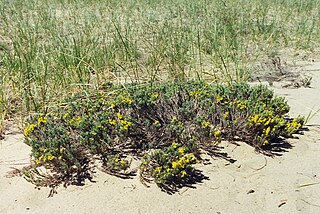
Hudsonia is a small genus of three species of flowering plants in the family Cistaceae, native to North America. They are typical of sand dune habitats.

Per Axel Rydberg was a Swedish-born, American botanist who was the first curator of the New York Botanical Garden Herbarium.

Ericameria ericoides, known by the common names California goldenbush, mock heather, and California heathgoldenrod, is a species of flowering shrubs in the daisy family. It is endemic to California, where it grows in the sand dunes and coastal hills between the northern San Francisco Bay Area and the Los Angeles area.

Erythronium grandiflorum is a North American species of plants in the lily family. It is known by several common names, including yellow avalanche lily, glacier lily, and dogtooth fawn lily. The Ktunaxa name for glacier lily is maxa.

Chaetopappa ericoides is a species of flowering plant in the daisy family known by the common names rose heath and heath-leaved chaetopappa. It is native to the southwestern and western Great Plains regions of the United States, plus northern Mexico. It is found in California, Nevada, Arizona, Utah, New Mexico, Colorado, Wyoming, Texas, Oklahoma, Kansas, Nebraska, Chihuahua, Coahuila, Sonora, Durango, Zacatecas, San Luis Potosí, and Nuevo León.
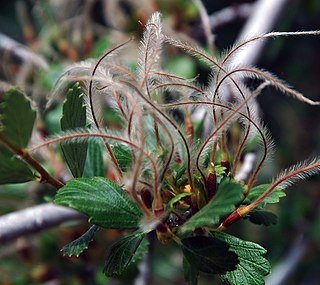
Cercocarpus montanus is a North American species of shrub or small tree in the family Rosaceae native to northern Mexico and the western United States. It is known by the common names alder-leaf mountain-mahogany, alder-leaf cercocarpus, and true mountain-mahogany. The variety argenteus is commonly known as silverleaf mountain-mahogany.

The Centennial Mountains are the southernmost sub-range of the Bitterroot Range in the United States states of Idaho and Montana. The Centennial Mountains include the Western and Eastern Centennial Mountains. The range extends east from Monida Pass along the Continental Divide to Henrys Fork 48 km (30 mi) NNW of Ashton, Idaho; bounded on the west by Beaver Creek, on the north by Centennial Valley and Henrys Lake Mountains, on the east by Henrys Lake Flat, and on the south by Shotgun Valley and the Snake River Plain. The highest peak in the range is Mount Jefferson.
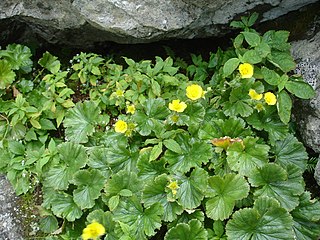
Geum radiatum is a rare species of flowering plant in the rose family known by the common names spreading avens, Appalachian avens, and cliff avens. It is native to the region of the border between Tennessee and North Carolina in the southeastern United States, where there are eleven known populations remaining. The plant was federally listed as an endangered species in 1990.
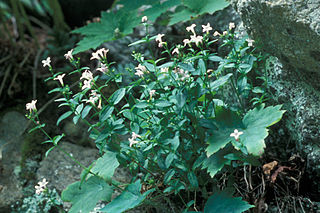
Houstonia purpurea is a species of flowering plant in the coffee family known by the common names Venus's pride, woodland bluet, and purple bluet. It is native to the eastern United States from eastern Texas and Oklahoma east to Florida and Pennsylvania, with scattered populations in Nebraska, Iowa, Michigan, New York State and New England.
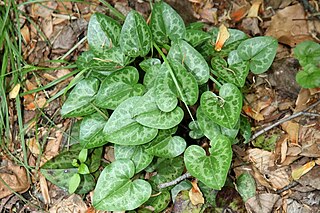
Hexastylis naniflora is a rare species of flowering plant in the birthwort family known by the common name dwarf-flowered heartleaf. It is endemic to the Piedmont region of the United States, where it is limited to a small area straddling the border between North Carolina and South Carolina. It is a federally listed threatened species.

Liatris punctata is a species of flowering plant in the aster family known by the common names dotted gayfeather, dotted blazingstar, and narrow-leaved blazingstar. It is native to North America, where it occurs throughout the plains of central Canada, the central United States, and northern Mexico.
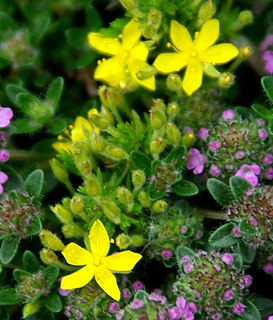
Hudsonia ericoides is a species of flowering plant in the rock-rose family known by the common names pine barren goldenheather, false heather, and golden-heather. It is native to eastern North America, where its distribution extends down the east coast from Newfoundland to Delaware, with a disjunct population in South Carolina.

Hudsonia tomentosa is a species of flowering plant in the rockrose family known by the common names woolly beachheather, beach heather, and sand heather. It is native to northeastern North America, including central and eastern Canada and the northeastern United States.




















